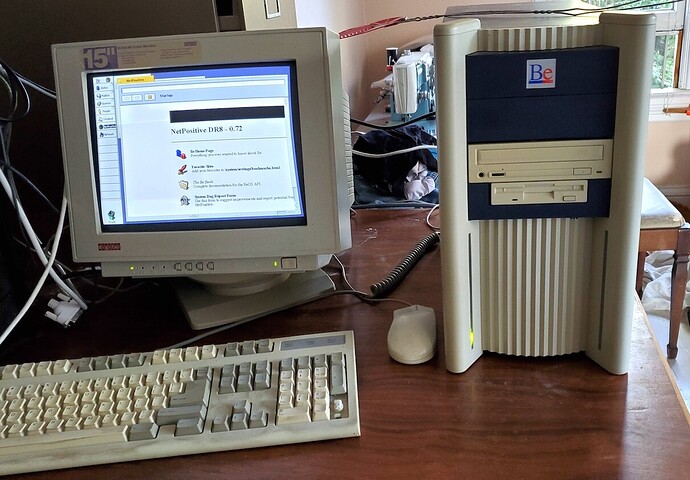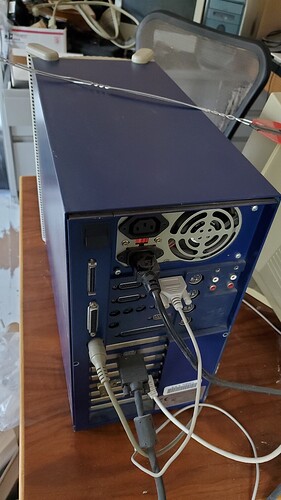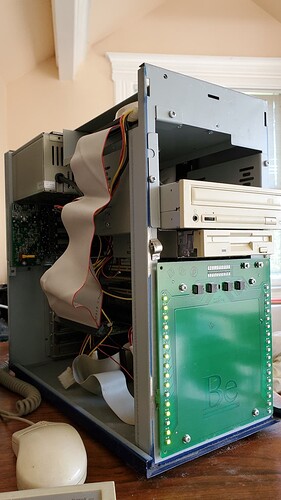I’ve just posted in a few places and am dealing via email right now. I’ve just started the process.
How’s it going? It would be a good time for me to unload mine, so it’s interesting to hear about the market.
Mine’s 133Mhz too. Seems to be all working, minus the network, which is likely just a configuration or environment issue. I installed Developer Release 8.1 on it, because this thing is more about being historical than being useful and that looked pretty historical. (I wish I remembered that era more clearly - something about a database filesystem, with an interesting API …)
You get the box, mouse, keyboard, and a box full of BeOS release material up through release 4 (I think I have 5 around here somewhere, but right away I don’t see it in the box here, so no guarantee), Code Warrior, etc. And Zeta.
The last picture should show, if you look close, that a couple LEDs aren’t lighting up. (A little light, but not bright.) The network issue, don’t know - it certainly used to work, but after this install I spent a couple minutes on it and gave up.
All for $2K plus shipping cost. Significant discount to anyone who can pick it up, because putting this thing in the mail is the last thing I want to deal with. I’m in Seattle, and not interested in mailing it overseas. But - in the not too distant future, I expect it will be in Portugal, if it’s still in my possession.
Please send me a DM. I’m interested in discussing your BeBox for sale.
Hi Donn, I’m interested too, second in line. The price is ok for me. Looks that I can’t send you a PM, can you contact me? Thanks
Did this machine get sold, or still up for grabs? Southern California, doing some R5 porting.
Welcome! Glad to have you here.
Yes, it’s on a delivery vehicle as I write this.
FYI, I just sold my higher end version, with mouse, keyboard, monitor, 12 OS CD/DVDs, user manual and dev binder, for 4K (I paid shipping and insurance.)
So anybody saying they don’t sell for that is wrong. I never even listed mine. Didn’t try an auction. Just a few posts like this and sold it privately. Took a few months to negotiate and validate but got the money today.
Hi, I am the proud purchaser of Donn’s BeBox.
I received it, and it is really beautiful! Thank you so much Donn for this.
I am part of an association that restores and exhibits old machines in Switzerland (www.occc.club) and we will now be able to show a real BeBox at our exhibitions thanks to Donn 
Have a nice day.
Oh so we can have two of them at the next Alchimie? 
ha, would be cool, for sure, but unfortunately, I think I will have to avoid alchemy for a while…
Two BeBox in very nice condition here in this thread…
While I agree these are more historical than practical now, DR 8.1 is stretching it far. The database filesystem was terrific on paper but suffered from regular crashes which caused the dreaded “reindexing database” message upon reboot… and the loss of whatever you had actually filed into the database to make, say, your address book.
The database filesystem had to go, together with the legacy from the earlier Hobbit prototypes—which were intended as appliances for home automation rather than as general purpose “computers”. Enter BFS and the “modern” Be APIs.
The change was for the better and much improved, but one casualty was the “Lois and Clark” pair (browser and web spider, because in those times of modem connection there was a benefit to download a local copy of your favourite pages to then browse offline at no cost!). Lois has a sleek, and totally unique, look among web browsers (even to this day!): It displayed two pages side by side, like a book. I loved it! Unfortunately, Lois and Clark were never ported over from DR releases. ![]()
A DR 8.1 BeBox is the opportunity to bring up Lois from the past, but I suppose one also has to setup one’s own web server, filled with suitable Web 1.0-formatted content.
BTW, “Lois” stands for “Land of Internet Solution”. Now if I could remember about its companion “Clark”…
Back in the day, I wasn’t very sorry to see the database filesystem go. I don’t remember the crashes, but there was some annoying file record size limit, that affected the API; a file over that limit needed a reference to an item outside the database record. As I vaguely recall. And it isn’t like I ever found a compelling advantage for the system.
I’d like more details on this if possible.
I’d like to… but I only began to use BeOS around the time of the DR8/PR1 transition. Hobbit BeBoxes were long since history. I never saw one, not even at Be European headquarters, and only know about them from hearsay.
As I understood it, the Hobbit BeBox was originally intended as “the” device to bind all of devices which enabled the perfect “year 2000” house: Heating/cooling, motorised blinds, music, etc. Plus holding your phone book, and whatever developers would come up with. Home automation, not computing. (Think Siri/Alexa/Google Home without the voice command, which was firmly the realm of science-fiction a quarter of a century ago.)
It was considered an asymmetric multi-processing design, with 3 DSPs assisting the 2 Hobbit CPUs, which were no power horses. (Apple considered the Hobbit to power its Newton personal assistant, but eventually went for ARM because the Hobbit lacked computing power. The rest is history…) Be was not bothered by the computing weakness of the Hobbit. But AT&T cancelled the Hobbit after loosing support from Apple, so Be needed something else. The next off-the-shelf low power CPU was Motorola’s PowerPC 603 (not ‘e’!), already a giant step up from the Hobbit. Two 603 would already do a lot more than all five main chips in the Hobbit box, and the PowerPC BeBox evolved to look more and more like a computer. (“I didn’t know a 603 could do that!”, as a Motorola engineer reportedly said after a demo.)
With the 603e, the next iteration of the BeBox was even a very capable computer. My 604e PowerWave (8600 clone) had objectively more processing power than a 133 MHz BeBox, but the BeBox always felt the snappier of the two computers because it reacted instantly to mouse clicks while the Mac (clone) took a split second to react—even running the same BeOS, the beige box still had this small, insignificant, but noticeable, delay compared to its blinking blue neighbour.
The last remnant of “home automation device” in the PowerPC BeBox was the GeekPort, which could input and output signals at much higher voltage than typically used by computers to communicate; that could allow, for instance, to directly power a small motor from the BeBox. When Be stopped making its own hardware, BeOS no longer had any active connection to its home automation origin.
I’ve asked for more details because from what I have read in different sources initially, BeBox was supposed to be a communications terminal connected to BBS/CompuServe, sort of like Minitel terminals. Here’s a quote from one of the articles: “At one time Be had cast the box as more of a telephony device, with voice-mail functions and a role as a bulletin board. Gassee said the
company scaled back in that arena”
Thanks for insight. That fits nicely with the media capacities of the successive BeBoxes.
I mostly remember a home automation story, but the “home automation” and the “communication box” concepts are actually not incompatible; it might have been both, or one and then the other.
There’s one on sale in France it seems, no shipping. With an extra motherboard, but the seller doesn’t seem to make his mind on if it works or not. I find the price tag a bit high but it seems possible to bargain.
The front panel looks 3D printed on the picture, with some original bebox elements missing. Looks fake.
looks legit to me. What do you think it’s missing?


